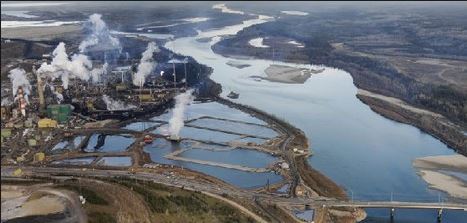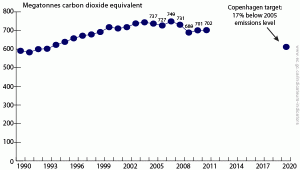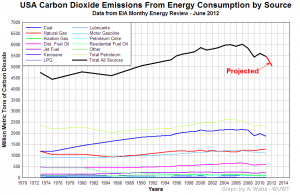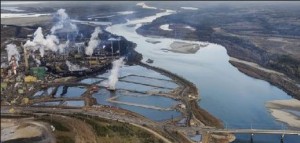November 4, 2013 – The oil sands projects in Alberta and Saskatchewan are the prime reason that Canada continues to increase CO2 output in total contradiction to its promises made at Copenhagen in 2009. This information comes from the latest Environment Canada National Inventory Report on greenhouse gas sources and sinks submitted to the United Nations Framework Convention on Climate Change this year.
Canada’s contribution to global greenhouse gas emissions is overall not that significant, in fact a mere 2%. But in terms of per capita contributions Canada produces 20.4 tons, among the highest in the world. When Canada committed at Copenhagen to reduce its emissions to 17% below 2005 levels by the year 2020 (the same commitment made by the United States), the country had seen decreases in overall greenhouse gases from a peak of 749 megatons in 2007 to 689 megatons in 2009. Since 2009 however, Canada’s greenhouse gas emissions have trended upward. Today the report states that total emissions of greenhouse gases are at 702 megatons CO2 or equivalent.
Where the country has decreased emissions in generating electricity by closing coal-fired power plants, by seeing improvements in overall vehicle emissions as new transportation technology is purchased, and by the reduction of manufacturing in the overall economy. Interestingly the overall fossil fuel industry’s contribution to greenhouse gases has been relatively flat, a mere increase of 0.1% with decreases in emissions from natural gas production and conventional crude. But in production of synthetic crude, the bitumen from the oil sands, emissions were up even though per unit of production greenhouse gas emissions had declined by 26%. The problem is production continues to increase outpacing intensity reductions, the way the current government in Canada chooses to measure its greenhouse gas contributions from bitumen. And Canadian forecasts predict oil sands production to grow from the 1.1 million barrels per day in 2005 to 3.3 million by 2020. To remain at current emission levels by 2020 that would mean intensity reductions of 66% per barrel of bitumen and that is highly unlikely. In fact, the exact reverse is occurring in carbon intensification within the industry. From 2005 to 2011 when production of bitumen rose 64%, CO2 emissions went up a comparable 76%. So even the commitment to reduce CO2 per barrel is not happening. Instead Environment Canada predicts emission rates overall will rise to 734 megatons by 2020, 5% above 2011 levels and almost 20% greater than our Copenhagen pledge.
Now let’s look at the United States and its latest report from the Energy Information Administration. Like Canada the U.S. made a 17% reduction commitment at Copenhagen in 2009. And like Canada U.S. greenhouse gas emissions have a heavy component of production from the energy industry. Where we have oil sands the U.S. has coal, by far the largest contributor of greenhouse gas emissions. But because of hydraulic fracturing and new natural gas production the U.S. is decreasing its reliance on coal-fired power plants. At the same time the country is expanding its investment in wind and solar energy. The result, in terms of energy industry emissions, has reached levels not seen since 1994, 12% below the 2007 greenhouse gas emission peak.
Schemes to sequester carbon from oil sands production in Canada don’t exist. And other carbon sequestration projects have foundered over the past two years even though both provincial and federal money has been committed. It would seem, therefore, that the energy companies vested in the oil sands can find no economically sustainable reason to motivate them to reduce greenhouse gas emissions.
In addition new harvesting technology such as steam-assisted bitumen mining isn’t proving to be significantly less carbon intensive than the older strip mining methods used to harvest and process oil sands.
The implications of this latest Environment Canada report does not bode well for the Keystone XL pipeline. The American decision to proceed with the pipeline is predicated on reviewing its impact on greenhouse gas emissions. And although it is true that a pipeline in and of itself doesn’t produce a lot of CO2, the product being conveyed inside it certainly does. President Obama has stated, “Our national interest will be served only if this project doesn’t significantly exacerbate the problem of carbon pollution.” The only way that could happen is if the oil produced replaced coal. But that’s not the plan. Keystone XL bitumen will be refined in Texas and much of it will end up being exported. American investment in natural gas, and renewable energy will replace coal.












